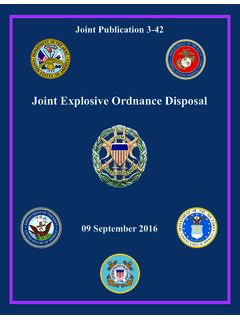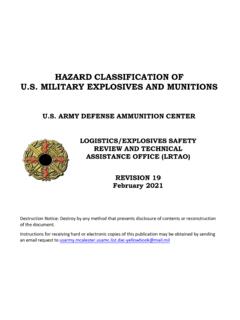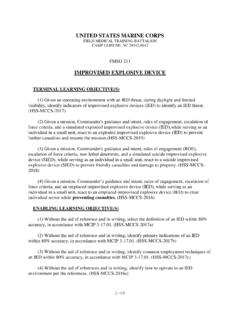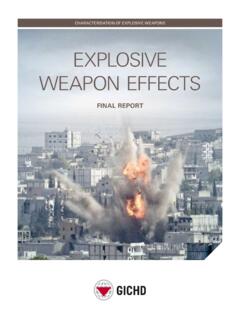Transcription of FM 4-30 FEF 071500JAN14-rp - United States Army
1 FM 4-30. ordnance OPERATIONS. APRIL 2014. DISTRIBUTION RESTRICTION: Approved for public release; distribution is unlimited. HEADQUARTERS, DEPARTMENT OF THE army . This publication is available at army Knowledge Online ( ). To receive publishing updates, please subscribe at FM 4-30. Field Manual Headquarters No 4-30 Department of the army Washington, DC, 1 April 2014. ordnance Operations Contents Page INTRODUCTION ..iv Chapter 1 THE ordnance CORPS .. 1-1. The ordnance Corps Mission .. 1-1. ordnance Functions .. 1-1. ordnance Corps and the Sustainment Warfighting Function .. 1-3. Summary .. 1-4. Chapter 2 MUNITIONS 2-1. Munitions Mission .. 2-1. Munitions Support Structure and Stakeholders .. 2-2. Strategic and Joint Partners .. 2-2. Operational Munitions Stakeholders .. 2-5. Brigade Level Munitions Operations .. 2-8. Ammunition Support Activities.
2 2-11. Forward Arming and Refueling Point .. 2-11. Ammunition Requirements 2-12. Disposition and Retrograde .. 2-12. explosives Safety .. 2-13. Summary .. 2-14. Chapter 3 explosive ordnance DISPOSAL (EOD) 3-1. explosive ordnance Disposal Mission .. 3-1. EOD Organization .. 3-2. Brigade Level EOD Organizations .. 3-4. Joint Operational Phasing Construct .. 3-5. Summary .. 3-6. Chapter 4 MAINTENANCE OPERATIONS .. 4-1. Section I Maintenance Fundamentals .. 4-1. Two-Level Maintenance .. 4-1. Section II Strategic Maintenance 4-2. United States army Materiel Command .. 4-2. Distribution Restriction: Approved for public release; distribution is unlimited. i Contents Section III Echelons above Brigade Operational Organizations .. 4-4. Modular Organization Maintenance Responsibilities .. 4-5. Section IV Echelons above Brigade Sustainment Organizations .. 4-6.
3 Theater Sustainment Command .. 4-6. Expeditionary Sustainment 4-6. Sustainment Brigade .. 4-6. Combat Sustainment Support Battalion .. 4-7. Support Maintenance Company .. 4-7. Section V Brigade Combat Team Maintenance 4-7. Field Maintenance Company .. 4-7. Forward Support Company .. 4-8. Section VI Combat Aviation Brigade 4-8. Aviation Support Battalion .. 4-8. Headquarters and Support Company .. 4-9. Forward Support Company .. 4-9. Section VII Test, Measurement, and Diagnostic Equipment Support .. 4-9. Section VIII Contracted Maintenance Support .. 4-10. Systems Support Contracted Capability .. 4-10. Summary .. 4-10. GLOSSARY .. Glossary-1. References-1. INDEX .. Index-1. Tables Table 3-1. explosive ordnance Disposal rules of 3-2. ii FM 4-30 1 April 2014. Preface This field manual (FM) 4-30 provides fundamental guidance for the employment of United States army ordnance maintenance operations, munitions operations and explosive ordnance disposal operations in support of unified land operations and warfighting functions.
4 Unified land operations are how the army seizes, retains, and exploits the initiative to gain and maintain a position or relative advantage in sustained land operations through simultaneous offensive, defensive, and stability operations in order to prevent or deter conflict, prevail in war, and create the conditions for favorable conflict resolution (ADRP 3-0). The principal audience for FM 4-30 is all members of the profession of arms. Commanders and staffs of army headquarters serving as a joint task force (JTF) or a multinational headquarters should also refer to applicable joint or multinational doctrine concerning the range of military operations as well as joint or multinational forces. Trainers and educators throughout the army will also use this publication. Commanders, staffs, and subordinates ensure their decisions and actions comply with applicable United States , international, and in some cases, host-nation laws and regulations.
5 Commanders at all levels ensure their Soldiers operate in accordance with the law of war and the rules of engagement. (See FM 27-10.). FM 4-30 uses joint terms where applicable. Selected joint and army terms and definitions appear in both the glossary and the text. Terms for which FM 4-30 is the proponent publication (the authority) are italicized in the text and are marked with an asterisk (*) in the glossary. Terms and definitions for which FM 4-30 is the proponent publication are boldfaced in the text. For other definitions shown in the text, the term is italicized and the number of the proponent publication follows the definition. FM 4-30 applies to the Active army , army National Guard of the United States , and United States army Reserve unless otherwise stated. The proponent of FM 4-30 is the United States army ordnance School. The preparing agency is the United States army Combined Arms Support Command, Training Support and Doctrine Directorate.
6 Send comments and recommendations on a Department of the army (DA) Form 2028 (Recommended Changes to Publications and Blank Forms) to Commander, United States army CASCOM, ATTN: ATCL-TS (FM 4-30), 2221 A Ave, Ft. Lee, VA 23801; or submit an electronic DA Form 2028 by e-mail to: 1 April 2014 FM 4-30 iii Introduction The purpose of the ordnance corps is to support the development, production, acquisition and sustainment of equipment- including weapons systems and munitions- and to provide explosive ordnance disposal (EOD), during peace and war, to provide superior combat power to the United States ( ) army . The ordnance corps has a rich and robust history of supporting the force dating back from the American Revolution to present day. The future of our nation and army will continue to be engaged in an era of persistent conflict a period of protracted confrontation among States , non-state, and individual actors increasingly willing to use violence to achieve their political and ideological ends.
7 The ordnance corps must evolve and remain the indispensable sustainment warfighting function in order for the army to successfully execute simultaneous and protracted operations. The army sustainment concept is based on the integration of people, systems, material, health services, and other support that links sustainment to the operations process. Sustainment is the provision of logistics, personnel services, and health services support necessary to maintain operations until mission completion (ADP 4-0). The ordnance corps plays a vital role in supporting the sustainment warfighting function through the sub function of logistics as referenced in army doctrine reference publication (ADRP) 3-0. Unified Land Operations. Logistics include the planning and executing the movement and support of forces. It includes those aspects of military operations that deal with: design and development, acquisition, storage, movement, distribution, maintenance, evacuation, and disposition of materiel; movement, evacuation, and hospitalization of personnel; acquisition or construction, maintenance, operation, and disposition of facilities; and acquisition or furnishing of services (JP 4-0).
8 Today modularity requires the ordnance corps to anticipate, analyze, and tailor available resources for effective and timely maintenance, munitions, and EOD support. Adaptive planning and increased options for decision makers now necessitate maintenance, munitions, and EOD managers to embrace change, innovation, and flexibility at all levels. The ordnance corps success is measured by how well it supports unified land operations with the elements of maintenance, munitions and EOD support. FM 4-30 contains four chapters: Chapter 1 covers a summative history of the ordnance corps and outlines the core competencies of the ordnance corps and their strategic relevance in sustaining the army 's unified land operations function. Chapter 2 discusses the tactical and operational mission of ordnance munitions operation as a major factor in determining the outcome of offensive, defensive, stability, support, protection and other combat operations.
9 Chapter 3 discusses EOD operations, organizational structure, their command and support relationships and how they support unified land operations. Chapter 4 discusses the two levels of maintenance concept and how maintenance support is provided above and below the brigade level. Chapter 4 also identifies the command and support relationships between the army Materiel Command (USAMC) maintenance sustainment organizations and the operational army in the conduct of unified land operations. iv FM 4-30 1 April 2014. Chapter 1. The ordnance Corps The ordnance corps has a proud tradition dating back to colonial America. In 1629, Samuel Sharpe was appointed as the first Master Gunner of ordnance for the Massachusetts Bay Colony. The American Revolution established the general outlines of the future ordnance Department. During the war Colonel Benjamin Flower and Ezekiel Cheever, a civilian, provided ordnance support in the manufacturing of arms and equipment and supplied support to the army in the field.
10 During the War of 1812, the Secretary of War recognized the need for a distinct branch to manage the procurement, research, and maintenance of ordnance materiel. On May 14, 1812, Congress officially established the ordnance Department and appointed Colonel Decius Wadsworth as the first Chief of ordnance . This chapter provides an introduction to the ordnance corps, its four functions, and how the ordnance corps supports the army 's operational concept of unified land operations by operating within the context of the sustainment warfighting function. THE ordnance CORPS MISSION. 1-1. The ordnance corps mission is complex and multi-faceted, providing munitions, maintenance, and EOD support to generate and maintain combat power and to provide protection to army , joint, intergovernmental, interagency and multinational forces. This support begins at the very inception of operations and continues, unabated, until operations are complete.















